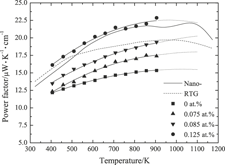Article contents
Enhanced electrical conductivity in Si80Ge20B0.6 alloys with Er addition prepared by spark plasma sintering
Published online by Cambridge University Press: 07 June 2011
Abstract

Si80Ge20B0.6 thermoelectric alloys with minute erbium (Er) addition were prepared by the spark plasma sintering technique. The samples with different amounts of Er additions were analyzed by x-ray diffraction, x-ray fluorescence, and x-ray photoelectron spectroscopy. The thermoelectric properties were measured from 400 to 900 K. Effects of the amount of Er addition on the thermoelectric properties of Si80Ge20B0.6 alloys were investigated. New findings indicate that the Er-added alloys have larger carrier concentrations than the pristine sample. The larger carrier concentration appears to make a significant contribution to the electrical conductivity. Seebeck coefficient decreases with the increase of carrier concentration, whereas the power factor increases with increasing electrical conductivity. It was generally believed that the scattering of phonons by carriers may result in the thermal conductivity reduction. The samples with Er addition exhibit better figure of merits than the pristine sample. The optimal ratio of Er addition is actually in the range of 0.085–0.125 at.%.
Keywords
- Type
- Articles
- Information
- Journal of Materials Research , Volume 26 , Issue 15: Focus Issue: Advances in Thermoelectric Materials , 14 August 2011 , pp. 1879 - 1885
- Copyright
- Copyright © Materials Research Society 2011
References
REFERENCES
- 4
- Cited by




